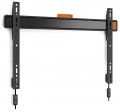Minimum size
The minimum TV screen size that can be mounted on the stand/mount. It is usually indicated for structures with mounts, for stands this parameter is irrelevant (for more details, see "Type"). The parameter is not absolutely accurate, because technically, TVs with a smaller size can fit the mount; however, in general, it allows to evaluate the scope of a particular model of mount/stand.
Max. weight
The maximum weight of the TV that can be installed on the mount/stand; more specifically, it is the maximum weight that the mount/stand can support for an indefinitely long time without any negative consequences. Unlike the screen size described above, this parameter is accurate and should not be exceeded: perhaps the stand/mount will not break immediately under excess weight, but this can happen at any time, and such a breakdown is not covered by the warranty.
It is worth considering that for classic stands with several shelves (see "Type"), the maximum wheight is usually indicated for the entire structure as a whole and is the sum of the loads for each individual shelf. Thus, the maximum weight of the TV is not limited by the total maximum wheight, but by the maximum wheight for one shelf. This does not apply to stands with mounts; they usually list the maximum wheight on the mount, in which case it corresponds to the maximum weight of the TV.
The screen size is directly related to the maximum wheight (after all, a large TV weighs more). Typically, for screens up to 24", structures with a maximum wheight of about 5-6 kg are usually quite enough, for a 32" device, about 12 kg may be needed, large 55" screens reach a maximum weight of about 25-30 kg, and in the case of plasma panels, these figures increase by 1.5-2 times However, anyway, before choosing, you should clarify the weight of the specific TV model for which the stand/mount is selected.
Minimum distance from the wall
The smallest possible distance between the wall on which the mount is hung and its farthest protruding point. First of all, the overall compactness of the design depends on the minimum distance: if you do not want the TV to protrude far forward from the wall, you should pay attention to models with a small minimum distance. And if the mount provides length adjustment, this parameter determines the limits of such adjustment.
Max. distance from wall
The maximum distance from the TV mounting point to the wall (in the case of ceiling mounts, to the ceiling) provided by the mount. See "Minimum distance from wall" for details.
VESA
VESA is generally accepted standard for most modern screens (TVs, monitors, plasma panels) and is found in all types of stands/mounts, except for classic stands (see "Type"), where the TV is placed on its own stand. Any such mount has 4 screws arranged in the shape of a rectangle (square). However, the size of this rectangle can be different, it depends primarily on the weight, and, accordingly, the size of the screen. The smallest mount today is
50x50 mm, it is designed for very miniature models;
100x100 mm can already hold TVs of about 24",
200x200 mm — 32", and in larger models, the size of the mount can reach
800x400 mm. Many mount/stand models have holes for several VESA standards.
The following sizes of VESA mounts are currently on the market:
50x50 mm,
75x75 mm,
100x100 mm,
100x200 mm,
200x100 mm,
200x200 mm,
200x300 mm,
200x400 mm,
300x200 mm,
300x300 mm,
300x400 mm,
400x200 mm ,
400x300 mm,
400x400 mm,
500x400 mm,
600x400 mm,
600x600 mm,
700x400 mm,
800x400 mm,
800x600 mm,
800x800 mm,
900x400 mm,
900x500 mm,
900x600 mm,
1000x500 mm,
1000x600 mm.

